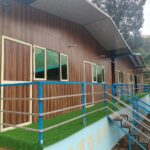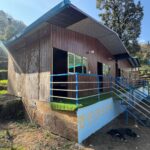Campfire Nights at Divine Chopta Cottages: Experience Adventure and Comfort
A campfire is more than just a source of warmth and light when you’re out in the wilderness. The central element of a camping experience brings people together, sparks conversations, and creates unforgettable memories. Whether you’re camping with friends, family, or a special someone, a campfire becomes the heart of the outdoor adventure. It symbolises warmth, connection, and tradition, evoking a sense of nostalgia and peace.
In this blog, we’ll explore everything about a campfire: its significance, how to build one safely, its role in outdoor camping, and the best activities and food ideas that revolve around a campfire. From the primal joy of gathering around a fire to the modern campfire rituals, we’ll dive deep into how the campfire has been and continues to be, an integral part of outdoor adventures.

The Significance of a Campfire in Camping
When people think about camping, the image of sitting around a campfire is often the first that comes to mind. A campfire is a key feature of outdoor adventures, serving multiple purposes. Let’s take a look at the significance of a campfire:
1. Connection with Nature
Building and sitting around a campfire takes you back to the basics. In today’s world of technological distractions, it allows you to disconnect from the hustle and bustle of daily life. The fire draws you into the present moment and brings you closer to nature. The smell of the wood burning, the sound of the crackling flames, and the warmth on your face – all these experiences help foster a deep connection with the natural world around you.
2. Social Bonding
A campfire is a social gathering point. It brings people together, creating an intimate atmosphere where you can talk, laugh, and share stories. Whether you’re camping with family, friends, or a partner, the campfire becomes the social nucleus of your adventure. It’s where relationships are nurtured, and shared experiences are created. Campfire stories, games, and music can help form lasting bonds and create a sense of community.
3. A Source of Warmth and Light
While modern camping might come with portable heaters and lanterns, nothing beats the warmth and light of a natural campfire. As the sun sets and the temperatures drop, the fire becomes a vital source of warmth. It also provides light in the darkness, allowing you to continue your activities long after sunset. The flickering flames illuminate the faces of those around you, enhancing the campfire experience and adding a magical quality to the outdoor atmosphere.
4. A Culinary Delight
A campfire isn’t just a place to sit around; it’s also a cooking tool. The fire provides a way to prepare food in the great outdoors, adding a rustic flavour to your meals. Grilling sausages, roasting marshmallows, and cooking meals over an open flame are integral parts of the camping experience. The smell of food cooking over the fire mingles with the fresh air, and the camaraderie of sharing a meal around the campfire creates a sense of satisfaction and connection.
How to Build a Campfire: A Step-by-Step Guide
Building a campfire is a skill that every outdoor enthusiast should have. Whether you’re a seasoned camper or a beginner, knowing how to properly build a campfire is essential for safety and comfort. Here’s a step-by-step guide on how to build a campfire:
1. Choose the Right Location
Before you start gathering wood, find a safe and appropriate location for your campfire. Look for a spot that’s away from overhanging branches, dry grass, and anything that could catch fire easily. Most campsites will have designated fire pits, which are the safest option. If you’re camping in a more remote area, make sure the location is on bare soil or gravel, not grass or leaves.
2. Gather Firewood
You’ll need three types of wood to build your fire:
- Tinder: Small, dry materials that will catch fire quickly. This could be dry leaves, pine needles, bark, or paper.
- Kindling: Small sticks or twigs that will catch fire from the tinder and help the fire grow.
- Fuel Wood: Larger logs that will sustain the fire once it’s established.
Make sure to gather enough firewood before you start building the fire. You’ll need a mix of small and large pieces to keep the fire going.
3. Prepare the Fire Pit
If you’re using a designated fire pit, clear the area of any debris such as leaves, twigs, and grass. Make sure that there’s no flammable material around the pit. If you’re not using a fire pit, create a circle of rocks to contain the fire. This will help prevent the fire from spreading to the surrounding area.
4. Build the Fire
Now that you have your tinder, kindling, and fuel wood, it’s time to build the fire. There are a few ways to do this, but the most common methods are:
- Teepee Method: Arrange the kindling in a cone shape, with the tinder placed at the centre. As the kindling catches fire, it will create a teepee structure that allows the fire to grow.
- Log Cabin Method: Place your tinder and kindling in the centre, then stack larger pieces of wood in a square shape around the smaller wood. This creates a “log cabin” structure that allows for good airflow and easy lighting.
- Lean-to Method: Lean larger pieces of wood against a smaller log or stick, with the tinder placed underneath. This method works well if you’re building a fire in windy conditions.
Once the structure is set, light the tinder with a match or a lighter, and gently blow on the base of the fire to help it catch.
5. Maintain the Fire
Once the fire is going, you’ll need to keep an eye on it. Add more fuelwood as needed to maintain the fire and keep it going for as long as you want. Avoid piling the wood too high, as this can smother the flames. Keep the fire small and manageable to reduce the risk of it spreading.
Campfire Safety Tips
While a campfire can be a source of warmth and enjoyment, it’s important to handle it safely. Here are some key safety tips to ensure your campfire is both fun and safe:
1. Always Keep The Fire Contained
A contained fire is a safe fire. Always use a fire pit if available, or create a fire ring with rocks to keep the fire from spreading. Never leave the fire unattended, and always make sure it’s completely extinguished before leaving the area.
2. Keep Water or Fire Extinguisher Nearby
Have a bucket of water or a fire extinguisher nearby in case the fire gets out of control. It’s always better to be prepared than to panic in an emergency.
3. Avoid Fires in High Winds
Strong winds can carry embers far from the fire, potentially causing a wildfire. If the wind picks up, it’s a good idea to extinguish the fire and wait until conditions improve.
4. Extinguish the Fire Properly
Before leaving your campsite, make sure the fire is completely out. Pour water on the fire, stir the ashes, and pour more water until the fire is cold to the touch. Never leave a campfire smouldering; this could lead to a wildfire.
Campfire Activities: Fun Things to Do Around the Fire
A campfire is more than just a source of light and warmth; it’s a place where you can engage in a variety of fun activities. Here are some ideas to make the most of your time around the fire:
1. Campfire Stories
One of the most traditional activities around a campfire is telling stories. These could be ghost stories, personal anecdotes, or legends about the area. A well-told story can captivate the group and add an air of mystery to the night.
2. Campfire Songs
If someone in your group plays a guitar or another instrument, campfire songs are a must. Sing along with your favourite tunes or make up funny songs about your camping adventures. Music creates a relaxing and festive atmosphere around the campfire.
3. Marshmallow Roasting
No camping experience is complete without roasting marshmallows over the campfire. Whether you’re enjoying them on your own or turning them into s’mores with chocolate and graham crackers, this activity is a must for any campfire gathering.
4. Stargazing
The quiet of the night, the warmth of the fire, and the beauty of the stars create a magical atmosphere for stargazing. Lie back, enjoy the peace, and look for constellations. If you’re camping in a remote location, the night sky will be clearer and more vivid than you’ve ever seen.
5. Campfire Cooking
Aside from roasting marshmallows, you can cook a variety of meals over the campfire, such as grilled vegetables, skewered meats, or foil-packet meals. Cooking over an open flame adds a rustic and flavorful touch to your meals, and it’s a great way to bond with your fellow campers.
A campfire is more than just a fire; it’s a symbol of adventure, warmth, and connection. From the moment you light it to the time it fades into embers, the campfire is a gathering point for creating memories, sharing stories, and building relationships. By understanding the significance, learning how to build a fire safely, and enjoying the activities that come with it, you can ensure that your campfire experience is both enjoyable and memorable. So next time you venture out into the great outdoors, make sure to light a fire and enjoy all that it brings to your camping experience.



